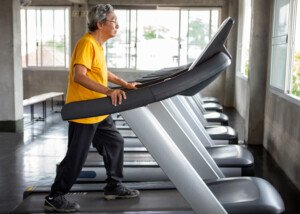
If you want the most out of a treadmill workout, then holding it with one hand and switching off with the other is NOT a smart way to walk or jog.
Holding on with one hand (whether you switch off with the other hand or not) isn’t as bad as clinging on with both hands simultaneously, but it’s still an inefficient way to walk or jog.
What’s especially peculiar about holding onto a treadmill with one hand alternating with the other or the same hand throughout — is that I’ve seen this only with women – and only those who appear to be over age 45.
I’ve been inside many gyms over a ton of years, so I’ve seen a LOT of people on treadmills.
I can’t help notice the strange habits that men and women have when it comes to using these machines.
Because I’ve always been a fitness and treadmill enthusiast (and am a former personal trainer), I always take note of how people use treadmills.
And one of the strangest things I’ve observed is when someone holds on with one hand.
The one-hand hold is the agnosticism of treadmill use. It’s like, gee, if you can walk with just one hand on the bar or rail, why not just let go and swing both arms instead of one arm?
These are able-bodied women. The treadmill might be on the second floor, and these women are seen using the stairs without any difficulty.
They exit the treadmill and walk away from it without any difficulty.
Holding on with one hand, then, is not a sign of disability. It’s a habit, and a bad one.

The image on the left shows correct walking. If you feel as though you might fall off without holding on … REDUCE THE SPEED. ©Lorra Garrick
“If you are using your hands to provide stability because there’s a safety issue [as in the case of someone with a physical disability], then obviously this makes sense,” says Ali H. Mesiwala, MD, a board certified neurosurgeon with DISC Sports & Spine Center in Newport Beach, CA.
“Alternatively, alternating hands without a good reason puts stress on the opposite side of the body in a way which is also problematic.”
You may think that feeling “like I’m gonna fall off” is a good reason to keep one hand on the machine.
But if you’re able-bodied, the lighting is good and you don’t have a balance disorder, there’s really no logical reason to walk with one hand holding onto something.
“In addition, using one’s arms [to hold onto the machine] also offloads the spine, and results in less work being performed, which also diminishes the value of the exercise,” says Dr. Mesiwala.
Switching the Hands
Perhaps the switching occurs because the women believe that using the same hand the entire time will create an imbalance.
After all, if you’re going to lock up one side of your upper body, the other side should get the same experience, to even things out. There’s some degree of rhyme and reason to this.
However, this doesn’t make the overall situation efficacious.
The upper body should not be locked up while walking – at all (other than to hold on to change the settings or drink water).
Holding a treadmill with one hand STILL causes a disruption in gait.
Evening things out by switching hands does not prevent this disruption.
It’s “better” to switch hands than to hold on with the same hand, but it’s still bad – because holding onto the treadmill, in any shape, way or form, is bad for the body.
I’ve trained many women of middle and senior age with a variety of issues including osteoarthritis, obesity and peripheral neuropathy.
Right from the get-go, I had them walking on a treadmill with no holding on, and they all did great.
What’s wrong with holding onto a treadmill with just one hand?
Your body is off-balance, even if you do switch hands. Again, the switching is preferable to using the same hand, but it’s the lesser of two negatives.
The solution is to let go with both hands and swing the arms naturally at your side.
Holding on, even with one hand and light fingers, trains your body to depend on something external to keep steady while walking.
Do you want to teach your body to depend on something external to keep steady while walking?
• This is a downgrade, not an upgrade.
• This isn’t fitness. It’s enabling.
• It’s dis-empowering.
What if you feel unsteady letting go?
Here’s a thought: Set the speed slower. Let your body adjust, or as I say, acclimate.
This can take five minutes to five sessions or anything in between.
If you feel unsteady navigating a slowly moving tread under your feet, this means you’ve successfully trained your body to depend on external support to feel stable. You need to undo this flawed training.
If your only goal is to get an elevated heart rate, you still need to let go.
After all, what if in real life somewhere, you need to be steady and secure on your feet – but there’s nothing to hold onto?
If your body is trained at navigating a moving tread with external support (holding onto the machine), it won’t fare too well in a real-life situation when balance and coordination are required.

 Dr. Mesiwala
Dr. Mesiwala























